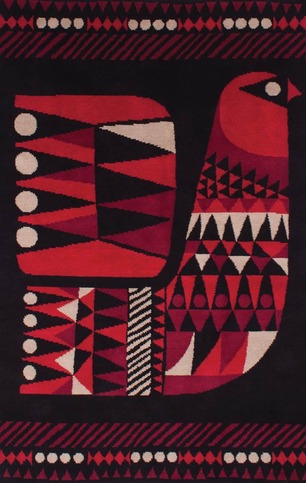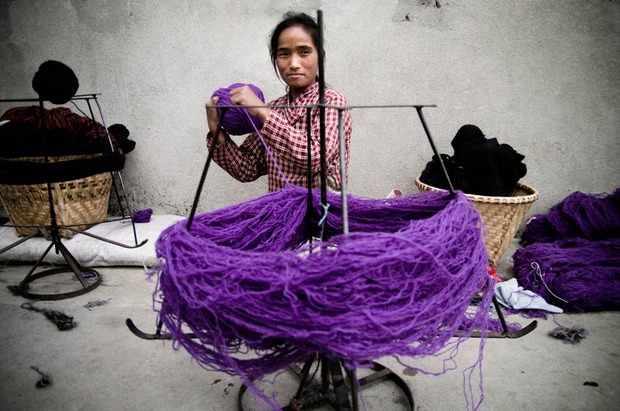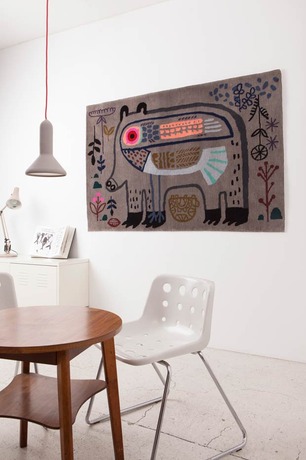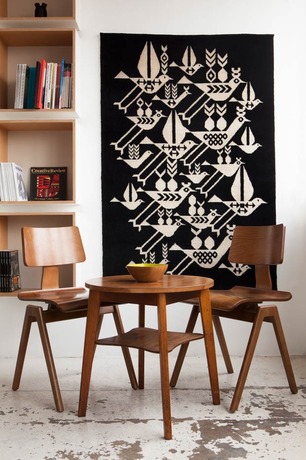18×18 by Node Fair Trade Rugs
Nepalese craftspeople team up with contemporary illustrators in a stunning collection



After founding fair trade rug company Node, illustrator Chris Haughton merged his art and craft sensibilities to conceive “18×18”, a collection of 18 fair trade rugs created in collaboration with 18 artists and designers launching exclusively at London’s Design Museum Shop.
Haughton commissioned rug designs from the creatives he most admired, scoring big with designers attracted to the the altruistic project supporting traditional carpet making skills in Nepal. Among the celebrated visual artists participating are Geoff McFetridge, Jon Klassen and Donna Wilson, headlining a truly international group with participation from American, Scandinavian, French, German, Italian, British and Irish artists.

For years Haughton has been illustrating for magazines and newspapers, and more recently authoring the award-winning children’s books “A Bit Lost” and “Oh no George!.” Node marks the latest venture in his renaissance arsenal.
“I love the work of fair trade and always wanted to develop work directly with producers,” he says. “I worked with six producers groups in India and Nepal. Of all the craft makers I worked with, I think meeting rug makers was most exciting because they were so relevant to my own work as an illustrator. When I began posting on my blog about the rugs in progress, the reaction from other illustrators was amazing, so I thought a group show would be a nice idea.”


The Node story is as much about the people who make the rugs as it about beautiful designs for the home. On his travels through Nepal three years ago, Haughton encountered the country’s long tradition of Tibetan carpet weaving and met the founder of the Kumbeshwar Technical School in Kathmandu. He recounts how this non-profit organization was started in a family home in the 1980s. “The workshop we work with has an amazing story,” says Haughton. “It was set up by the Khadgi family whose traditional role, being from a low caste, was cleaners and roadsweepers. Their grandfather made a fertiliser business from waste and when this business grew, he wanted to help the rest of his caste out of poverty. There was very little social mobility then and so he set up an adult training center to teach literacy, weaving and carpentry.”

In addition to fair wages, Kumbeshwar’s work supports a school of 250 children and an orphanage of 25. In the workshop all the carpets are made from bales of pure Tibetan wool, which is spun into thread, hand-dyed with natural, non-polluting dyes and then hand-knotted on looms into carpet. You can watch a short film of the spinners, dyers and weavers at work, showing how the Node rugs are made.
The process of working with so many different designers and coordinating the rug production in Nepal was challenging, says Haughton, but the effort was worth it. McFetridge, for one, was thrilled to be involved in the initiative. “For me collaborating with people is about putting myself into unique situations,” he says. “I am drawn to things that are handmade and thoughtfully produced. I know how difficult it is to make stuff in this way, so I am always looking to support projects like this.”

McFetridge goes on to explain his choice of a minimal hand signal design, saying, “I thought it would be interesting to do something very simple, a drawing that I had done very quickly, which would then be produced in this time-consuming process. I thought that the simplicity of what I did might draw attention to the artistry of the weaving.”
The designers aren’t the only ones who are delighted with the results—as Haughton emphasizes, the initiative is most importantly a fair trade initiative and the weavers in Nepal are also seeing the benefits of the collaboration “I’m very happy that Kumbeshwar are now thinking of scaling up and able to hire new weavers from the success of the show,” he says. “That’s what our aim was. Yes it’s important to support traditional crafts and see these skills being kept alive and re-invigorated, but this project is as much about giving work and skills to those who need a helping hand as it is about supporting traditional crafts.”


As well as ongoing designer collaborations, the future for Node lies prominently in its bespoke service for consumers who want to design their own rugs. “We have had great success with designers and illustrators weaving their own designs through us,” enthuses Haughton. “We’ve made rugs as wedding and engagement presents, made up a child’s drawing into a stunning rug, woven a local area map into rug for a small retail space and six massive rugs for a hotel in Ireland.”
Node’s 18×18 collection is now available to buy from The Design Museum. Each design is produced in a limited edition of ten.
Images by Peter Guenzel (in situ studio shots) and Carolin Weinkopf












